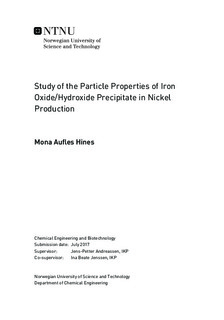Study of the Particle Properties of Iron Oxide/Hydroxide Precipitate in Nickel Production
Master thesis
Permanent lenke
http://hdl.handle.net/11250/2461108Utgivelsesdato
2017Metadata
Vis full innførselSamlinger
Sammendrag
The background for this thesis was crystallization of iron in nickel production at Glencore and a review of filterability properties of iron oxide/hydroxide precipitate. The nickel plant in Kristiansand produces nickel and cobalt by a chlorine leaching process with chloride electrowinning. Copper is produced by sulphate electrowinning. The aim of this thesis was to determine how different temperatures and supersaturation, due to residence time, affected the crystalline type and filterability of iron oxide/hydroxide precipitate.
Precipitation of iron oxide/hydroxide using divalent iron chloride were performed in a continuous system at 29, 65 and 79C with varying residence time. Sodium hydroxide was used as a base and hydrogen peroxide was added to oxidize the divalent iron. Supersaturation is mainly determined by pH and affect the crystal phase and size of the particles which are obtained. During a three week stay at Glencore experiments at 30, 65 and 90C were performed with solution from their process as feed material. Nickel carbonate and chlorine gas were used as base and oxidizing agent, respectively.
The oxidation/reduction potential and pH were monitored during the experiments and the oxidation ratio was measured with Ultraviolet visible spectrophotometer (UV-Vis). The filterability were examined using a BHS filtration unit, type of precipitation was determined by Powder X-ray Diffraction (PXRD) analysis and the particles were visually examined by using Scanning Electron Microscope (SEM).
At NTNU the precipitate was found to be ferrihydrite but a clear correlation between filterability, temperature and residence time could not be ascertained. Akaganeite was obtained for all the experiments at Glencore both for using process solution and divalent iron chloride as feed material. The filterability were improved both with increasing temperature and longer residence time, where the residence time had a higher impact than the temperature.
